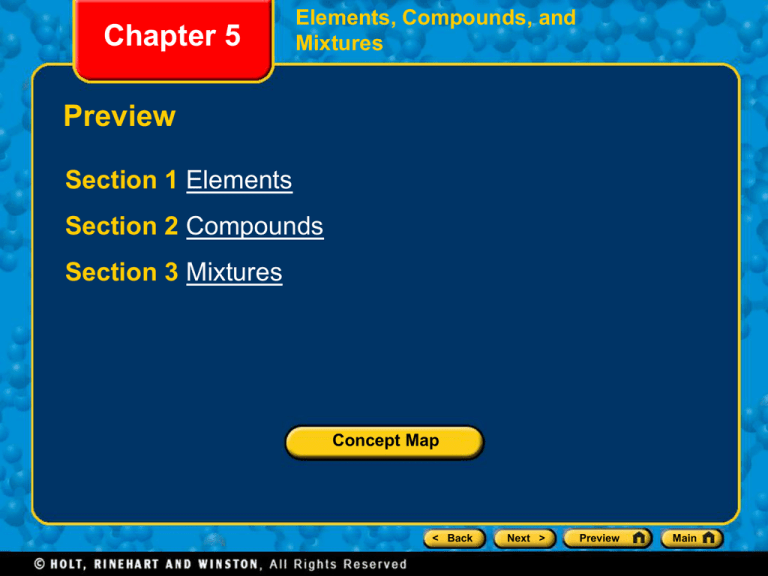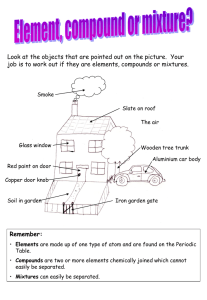Chapter 5 Elements, Compounds, and Mixtures
advertisement

Chapter 5 Elements, Compounds, and Mixtures Preview Section 1 Elements Section 2 Compounds Section 3 Mixtures Concept Map < Back Next > Preview Main Chapter 5 Section 1 Elements Bellringer List the names of five metals. Use your list to describe some of the properties of metals. Write your answers in your Science Journal. < Back Next > Preview Main Chapter 5 Section 1 Elements What You Will Learn • An element is a pure substance in which there is only one kind of atom. • An element cannot be broken down into a simpler substance by physical or chemical means. • Each element can be classified by a unique set of physical and chemical properties. • Based on their properties, elements are classified as metals, nonmetals, or metalloids. < Back Next > Preview Main Chapter 5 Section 1 Elements Elements, the Simplest Substances • An element is a pure substance that cannot be separated or broken down into simpler substances by physical or chemical means. • A pure substance is a substance in which all of the “building-block” particles are identical. • For elements, the building-block particles are called atoms. < Back Next > Preview Main Chapter 5 Elements, Compounds, and Mixtures Classification Scheme for Matter < Back Next > Preview Main Chapter 5 Section 1 Elements Classifying Elements • Each element can be classified by its unique set of characteristic properties. • Characteristic properties include physical properties and chemical properties. • Each element can be identified by its unique set of properties. < Back Next > Preview Main Chapter 5 Section 1 Elements Grouping Elements • Elements are classified as metals, nonmetals, or metalloids based on their properties. • Metals are shiny and conduct heat and electric current. Nonmetals are dull in appearance and do not conduct heat or electric current. • Metalloids have properties of both metals and nonmetals. < Back Next > Preview Main Chapter 5 Elements, Compounds, and Mixtures < Back Next > Preview Main Chapter 5 Section 2 Compounds Bellringer In your Science Journal, make a list of chemical properties and a list of physical properties. Then, read the following statement: “Salt is a compound that is composed of sodium and chlorine atoms. Therefore, sodium and chlorine must have properties that are similar to those of salt.” Is this statement true or false? In your Science Journal, write an explanation of your answer. < Back Next > Preview Main Chapter 5 Section 2 Compounds What You Will Learn • A compound is made up of two or more elements that are chemically combined to form a new substance with different properties. • During a chemical reaction, the reactant atoms of two or more elements interact and join to form molecules of one or more compounds. • Each compound has a unique set of physical and chemical properties that differ from the properties of the elements that make up the compound. < Back Next > Preview Main Chapter 5 Section 2 Compounds Compounds: Made of Elements • A compound is a pure substance composed of two or more elements that are chemically combined. • Elements combine by reacting, or undergoing a chemical change, with one another. • A chemical reaction is the process by which substances change into new substances. < Back Next > Preview Main Chapter 5 Section 2 Compounds Compounds: Made of Elements, continued • During a chemical reaction, the atoms of two or more elements react with each other to form molecules of compounds. • When two or more elements combine, a new compound is formed. The properties of the new compound are different from the properties of the elements that formed the compound. < Back Next > Preview Main Chapter 5 Section 2 Compounds Properties of Compounds • Each compound has unique physical and chemical properties. • A compound has properties that differ from the properties of the elements that make up the compound. • Elements always join in a specific ratio to form a specific compound. < Back Next > Preview Main Chapter 5 Elements, Compounds, and Mixtures Law of Definite Proportions < Back Next > Preview Main Chapter 5 Section 2 Compounds Breaking Down Compounds • The only way to break down a compound is through a chemical change. • Some compounds can be broken down into their elements. • Other compounds can be broken down to form simpler compounds instead of elements. < Back Next > Preview Main Chapter 5 Section 2 Compounds Compounds in Your World • The compounds found in nature are not usually the raw materials needed by industry. Often, these compounds must be broken down to provide elements or other compounds that can be used as raw materials. • Proteins and carbon dioxide are two compounds that play an important role in living things. < Back Next > Preview Main Chapter 5 Section 3 Mixtures Bellringer When you add sugar to lemonade, the sugar disappears. What do you think happens to the sugar? Write your answer in your Science Journal. < Back Next > Preview Main Chapter 5 Section 3 Mixtures What You Will Learn • Mixtures can be separated by physical means, such as distillation, filtration, and evaporation. • A solution is a mixture that appears to be a single substance but is composed of a solute dissolved in a solvent. • Concentration is a measure of the amount of a solute dissolved in a given amount of solvent. < Back Next > Preview Main Chapter 5 Section 3 Mixtures Properties of Mixtures • A mixture is a combination of two or more substances that are not chemically combined. • Each substance in a mixture keeps its identity because no chemical change happens when a mixture is made. < Back Next > Preview Main Chapter 5 Section 3 Mixtures Properties of Mixtures, continued • Mixtures can be separated by physical means, such as filtration, evaporation, and distillation. • The components of a mixture do not need to be mixed in a definite ratio. < Back Next > Preview Main Chapter 5 Elements, Compounds, and Mixtures < Back Next > Preview Main Chapter 5 Section 3 Mixtures Solutions • A solution appears to be a single substance, but it is actually a homogeneous mixture composed of particles of two or more substances that are distributed evenly among each other. • In solutions, the solute is the substance that is dissolved. The solvent is the substance in which the solute is dissolved. < Back Next > Preview Main Chapter 5 Section 3 Mixtures Solutions, continued • A substance that is insoluble, or unable to dissolve, forms a mixture that is not a solution. • Solutions may be liquids, gases, or solids. • Alloys are solid solutions in which metals or nonmetals are dissolved in other metals. < Back Next > Preview Main Chapter 5 Elements, Compounds, and Mixtures Solutes, Solvents, and Solutions < Back Next > Preview Main Chapter 5 Section 3 Mixtures Concentration of Solutions • Concentration is the amount of a particular substance in a given quantity of a mixture or solution. The terms concentrated and dilute do not tell you the exact concentration of solute. • Solubility is the ability of one substance to dissolve in another at a certain temperature and pressure. < Back Next > Preview Main Chapter 5 Elements, Compounds, and Mixtures < Back Next > Preview Main Chapter 5 Elements, Compounds, and Mixtures Concept Map Use the terms below to complete the concept map on the next slide. mixture filter element solution compound < Back Next > Preview Main Chapter 5 Elements, Compounds, and Mixtures Concept Map < Back Next > Preview Main Chapter 5 Elements, Compounds, and Mixtures Concept Map < Back Next > Preview Main






